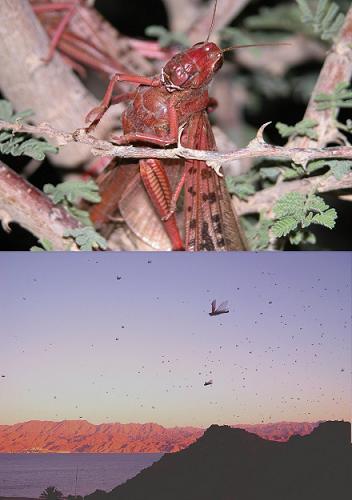Researchers from the Hebrew University discovered that the locust can use polarized light vision and thus avoid flying over the sea. The research was published in the journal of the Royal Society
Avi Blizovsky

Above: A locust on a tree - photo by Assaf Rivlin. Below: a swarm of locusts over the Red Sea. Photographer: Barak Guzner. Photos courtesy of Tel Aviv University
Direct link to this page: https://www.hayadan.org.il/locust0805.html
The migration of locusts has been considered since biblical times to be a plague controlled by spirits carrying the locust swarms. It is known that the desert locust or in its Latin name Schistocerca gregaria can migrate long distances in swarms that include millions of individuals. During the locust attack that happened in Israel in November 2004, it seems that the locust swarms arrived from Sinai in a low flight eastward to the edge of the Red Sea but turned north and did not cross it. Only after passing the Gulf of Eilat did part of the swarm head towards Aqaba and Jordan.
This observation prompted researchers from the ASA Department of the Hebrew University and the Inter-University Institute of Marine Sciences in Eilat to investigate how the locust recognizes the sea and knows how to avoid flying over it. The research focused on the grasshoppers' ability to distinguish polarized light. This is an ability that humans lack, but it exists among other things in fish, insects and squid. It is also known that there are insects such as water beetles and water beetles that use this ability to identify bodies of water.
The study was conducted by Dr. Nadav Shasher, who is considered one of the world's leading researchers in the field of polarized vision, together with research students Shai Sabah and Noa Aharoni. The study was recently published in the journal of
The Royal Society and in reports on research news that recently appeared in the journals Science
and Nature.
"To test whether the locust is able to distinguish polarized light, we tested the reactions of individuals tied by thin strings," says Dr. Nadav Shasher. "By exposing the locust to different surfaces with different polarization returns, we proved that individual locusts avoid flying over surfaces that reflect polarized light (such as mirrors and plastic) and turn to fly in a different direction.
"As we know, the sea reflects much more polarized light than the land and thus the two can be separated. When the locust individuals were given the option to choose between a surface reflecting diffused light and a surface reflecting polarized light, they showed a clear preference to fly over the surface reflecting diffused light."
These results suggest the desert locust's ability to detect polarized light reflected from bodies of water, at least, when flying at low altitude and thereby avoid passing over these dangerous areas where it cannot land and rest
Regarding the importance of the findings, Dr. Shesher says that it will be possible to use this feature of the locust to develop suitable substances that will distract the locust from flying and landing in areas where agricultural crops are grown.
The evolutionists - invertebrates
https://www.hayadan.org.il/BuildaGate4/general2/data_card.php?Cat=~~~241336086~~~197&SiteName=hayadan
